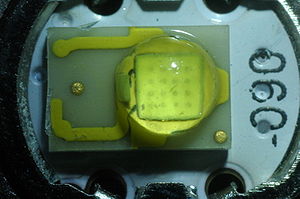Philips Lumileds: Difference between revisions
No edit summary |
(update on the Luxeon C) |
||
| Line 3: | Line 3: | ||
==Luxeon C== | ==Luxeon C== | ||
The Luxeon C looks similar to the Rebel, but is about a quarter of the size, has a flat window over the emitter instead of a dome, and is designed for less current. This LED is used in the Maglite Solitaire | The Luxeon C looks similar to the Rebel, but is about a quarter of the size, has a flat window over the emitter instead of a dome, and is designed for less current. It was first introduced in 2012. This LED is used in the Maglite Solitaire and 2xAAA Mini Maglite, introduced in 2012. [http://www.philipslumileds.com/pdfs/DS41.pdf Datasheet] | ||
{|class="wikitable" style="text-align: center; width: 400px;" | {|class="wikitable" style="text-align: center; width: 400px;" | ||
Revision as of 09:39, 13 October 2012
Philips Lumileds Lighting Company is based in San Jose, California. It was started in 1999 as a joint venture between Philips and Agilent (spun off of HP), but in 2005 Philips bought Agilent's share, so now it is part of Philips. They developed some of the first power LED's to be used in flashlights, like the Luxeon I, III, and V, and continue to produce the Luxeon Rebel. Red and blue Rebel LED's are used in the household lightbulb that won the L Prize for Philips in 2011.
Luxeon C
The Luxeon C looks similar to the Rebel, but is about a quarter of the size, has a flat window over the emitter instead of a dome, and is designed for less current. It was first introduced in 2012. This LED is used in the Maglite Solitaire and 2xAAA Mini Maglite, introduced in 2012. Datasheet
| Bin | 350mA 100% |
500mA 133% |
|---|---|---|
| 7 | 80-90 | 106-120 |
| 8 | 90-100 | 120-133 |
Luxeon Rebel

Used in a number of different Maglites flashlights. Also used in early versions of Fenix LxD/PxD series. Datasheet
| Bin | 350mA 100% |
700mA 175% |
1000mA 225% |
|---|---|---|---|
| H | 50-60 | 88-105 | 113-135 |
| J | 60-70 | 105-123 | 135-158 |
| K | 70-80 | 123-140 | 158-180 |
| L | 80-90 | 140-158 | 180-203 |
| M | 90-100 | 158-175 | 203-225 |
| N | 100-120 | 175-210 | 225-270 |
| P | 120-140 | 210-245 | 270-315 |
| Q | 140-160 | 245-280 | 315-360 |
| R | 160-180 | 280-315 | 360-405 |
| S | 180-200 | 315-350 | 405-450 |
Luxeon Rebel ES
Same size package as the regular Rebel but with a larger die under the dome, the Rebel ES is capable of output of 200 lumens at 700mA and 320 lumens at 1000mA. The brightness bins below are not directly comparable to the ones above since the ES series are rated at a higher current. Datasheet
| Bin | 350mA 55% |
700mA 100% |
1000mA 133% |
|---|---|---|---|
| T | 110-121 | 200-220 | 267-293 |
| U | 121-132 | 220-240 | 293-320 |
| V | 132-143 | 240-260 | 320-347 |
| W | 143-154 | 260-280 | 347-372 |
| X | 154-165 | 280-300 | 372-400 |
Past Products
Luxeon I a 1-watt LED capable of producing 30-60 lumens at 350mA, this LED was used in the Fenix L1S
Luxeon III a 3-watt LED LED capable of producing 60-90 lumens at currents up to 1400mA. Used in the Fenix L1T
Luxeon V a 5-watt LED
Luxeon K2 smaller than the earlier Luxeons, but with greater output of up to 140 lumens at 1500mA.
Luxeon K2 TFFC for "thin film flip chip"